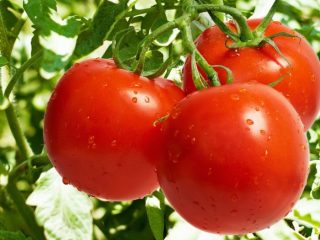Content
Winter is the time to make plans for the next summer season and choose new varieties of tomatoes, but when reading descriptions of a particular variety, you can often come across the terms determinate and indeterminate. And seeing these complex words, even experienced gardeners are often lost, let alone beginners.
But in fact, if you know what exactly is hidden behind these definitions, choosing a new variety that will satisfy all your requirements becomes much easier. Therefore, let’s try to figure out what a determinate tomato variety is, so that the choice of seeds is a conscious process.
A determinate tomato stops growing after tying 4 to 8 clusters. It follows that the indeterminate variety has no such limitation, and can grow upward and set an unlimited number of flower clusters.
The main differences between determinate and indeterminate tomato varieties
But this substitution is not always appropriate.Let's take a closer look at the differences between determinate and indeterminate tomato varieties.
Determinate varieties
What does determinant mean? Tomatoes with this mark usually produce the first ovary after 5-7 leaves, subsequent ovaries appear every two leaves. The main advantage of such tomatoes is the early harvest, which, as a rule, ripens at the same time. In addition, limited growth allows you to spend less time on garters and bush formation.
Determinate tomatoes well suited for growing outdoors (this applies to the middle zone). It is necessary to choose such seeds for growing in a greenhouse only in northern regions with cold and short summers.
If you do not form the bushes, you will get a plant overloaded with small fruits, which will not have enough strength to ripen all the tomatoes that have set.
The only exception will be standard tomatoes. These are the shortest varieties among determinate tomatoes; they have a strong stem, so they do not need either shaping or support. They are also called super-determinant, they are usually the earliest - they begin to bear fruit in 75-90 days. But for these advantages you will have to “pay” with the amount of harvest. Their limit is three brushes per bush.
For more information about pinching (what it is and why it is needed) of this tomato variety, see here:
Indeterminate varieties
Such tomatoes are unlimited in growth and, with proper care, can grow and produce crops all year long.The first ovary usually forms after 9-12 leaves, and then appears every three leaves. With proper care, you can collect up to a bucket of fruit from one bush per season. But for such high performance you will have to pay in labor costs.
Indets belong to remontant varieties, i.e. they repeatedly bloom and bear fruit, stopping the growing season only when the daily temperature drops. Fruiting begins 110 days after the appearance of the first shoots. Due to their considerable growth, such tomatoes are less likely to suffer from late blight, which usually affects the lower parts of the plant.
For other important details about growing tall tomatoes, see here:
Which variety is better to choose?
Now that you know all the pros and cons of both varieties, the natural question is what to choose. There is no clear answer to this question. The choice must be made according to several criteria:
- open or closed ground;
- climate zone;
- labor costs;
- cultivation purposes.
Firstly, you need to understand that only determinate varieties are suitable for open ground, which, in short summer conditions, can provide you with a small, but fairly good harvest. If you have a greenhouse at your disposal, then indeterminate varieties with proper care will give a larger harvest. But labor costs for maintaining these giants will also increase.
Secondly, do not forget to take into account the climate zone in which a particular variety will grow. In the northernmost regions, where growing tomatoes in open ground is impossible, even for a greenhouse it is worth choosing determinate varieties that will allow you to get a harvest in short summer conditions.
Thirdly, among the main differences between these varieties will be the time period during which the fruits will ripen. Indeterminate varieties will produce and set fruit at the same time. Determinate tomatoes will begin to ripen after all the bunches have set.
Fourthly, your choice will depend on the purposes for which you are growing tomatoes. If this is a hobby for you, then determinants are the ideal choice for you - minimal care and the tomatoes for harvesting are yours. But if you decide to grow tomatoes for sale and the main criterion for you will be the yield of the variety, then choose indeterminate seeds. But be prepared to provide them with proper care and nutrition, which these giants will need a lot of.
Seed manufacturers usually indicate this data on the back of the seed bag. If you make a thoughtful choice, the harvest will only please you.














